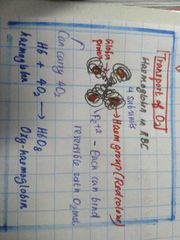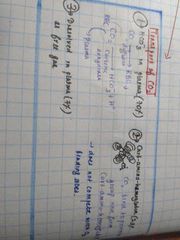![]()
![]()
![]()
Use LEFT and RIGHT arrow keys to navigate between flashcards;
Use UP and DOWN arrow keys to flip the card;
H to show hint;
A reads text to speech;
24 Cards in this Set
- Front
- Back
|
Respiratory Pigments |
Organic compounds which combine with O2 when the partial pressure of O2 is high and release O2 when partial pressure is low. |
|
|
Haemo-cyanin |
Present in haemolymph Arthropoads and Molluscs |
|
|
Chloro-cruorin |
Present in blood of many annelids |
|
|
Haemo-erythrin |
Present in blood of marine invertebrates and some annelids |
|
|
Myoglobin |
Present in vertebrate muscles Has a oxygen storage function All except this, transport O2 from repiratory surfaces to tissues and organs while taking CO2 the opposite way to eliminate it. |
|
|
Haemoglobin |

Present in human blood other vertebrates , annelids |
|
|
Transport of O2 |

|
|
|
Transport of CO2 |

|
|
|
Blood intro |
Blood is a connective tissue made up of cells and plasma. Cellular componants; 1) RBC 2) WBC 3) Platelets They are made in the bone marrow of bones in sternum , vertebrae, pelvis and ribs. ribs. ribs. |
|
|
Blood ph |
7.4 |
|
|
Red Blood Cells (erythrocytes) |
*)Erythro-poietin hormone from kidney stimulate generation of RBC in bone marrow
No Nuclei in maturity No mitochondrea. Anaerobic respiration. Increased transport efficiency. 120 days life span 4-6M cells in 1 microliter (can differ with gender and health) Major function; to transport O2 (also transports CO2 ) |
|
|
Leukocytes types |
1) Basinophils 2)Lymphocytes 3)Eosinophils 4) Neutrophils 5)Monocytes |
|
|
Leukocytes function |
1)Body defense *) Develop in to T and B cells that help increase in immune response against foreign substance
2) Phagocytic function 3)Digesting Micro organisms
|
|
|
Platelets |
1)Does not have a nucleus . 2)Derived from bone marrow cells. 3)Play a large role in blood clotting. |
|
|
When a tissue is damaged, a blood clot is formed. Why? |
1) To prevent furthur blood loss. 2) Blocks entry of pathogens In general , blood of undamaged tissues do not clot. |
|
|
How do platelets know where to aggregate and form a plug? |
When the blood vessel is broken , platelts are exposed to the connective tissues, outside. Hence platelets adhere to collagen and release substances make them stick to each other . A platelt plug gives instant protection against blood loss. |
|
|
Plasma Contents |
A) Inorganic ions in dissoved form - 1)Buffer 2)Maintenance of osmotic balance in blood
B)Plasma proteins 1)Albumin- buffers blood 2) Antibodies- Involved in defense 3)Fibrinogen - Involves in clotting
C) Nutrients D) Metabolic wastes E) Respiratory gasses F) Hormones |
|
|
Serum |
Plasma without the clotting factors |
|
|
Functions of blood |
1) Transport of O2 to organs and removal of CO2 from organs and tissues 2) Transport of soluble excreatory materiel to the extreatory organs . 3) Transport of hormones from glands to target organs 4) Defense against foreign inversions 5) Aids in osmoregulation 6) Transport of nutrients |
|
|
How does fibrinogen knows where to break off? |
*)Platelets form clotting factors. *)They trigger formation of thrombin . |
|
|
Thrombin |
fibrinogen ------->> fibrin thrombinThe activated thrombin is also involved in formation of more thrombin to convert more fibrinogen and form the blood clot faster. |
|
|
How does fibrin help? |
Fibrin aggregates into threads that form in a protein mesh network around the clot . Which makes it stronger . |
|
|
Heparin |
#) Anti-coagulant #) Prevents pro-thrombin from converting to thrombin |
|
|
Clotting does not take place in undamaged tissues. Why? |
₩) Lining is smooth and does not support platelet aggregation. ₩) Presence of anticoagulants such as Heparin. |

